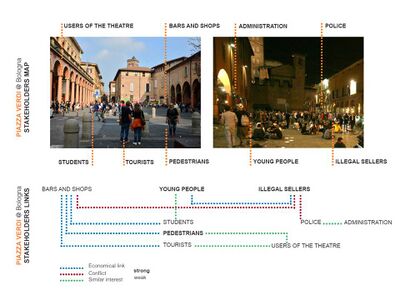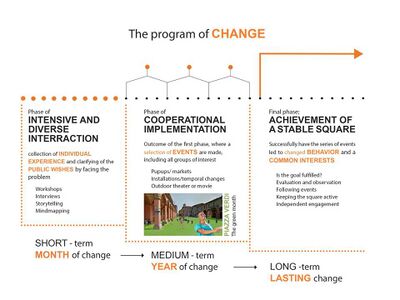LED 2016 Group F Democratic Change Process: Difference between revisions
| Line 22: | Line 22: | ||
== Concluding reflections == | == Concluding reflections == | ||
The main emphasis of our change model is to involve and engage people through | The main emphasis of our democratic change model is to involve and engage people to their daily landscape through continuous events and happenings. The case study we choose is the square of Bologna, Piazza Verdi. We choose it since it presents an unstable and frightening state during night, which results in unwanted activities and behavior that makes it unsafe for everyone. We thought that despite its particularities, it presents similar problems to other squares around the world, therefore a site-specific initiative was thought to be mandatory. | ||
Our change model is | Our change model is oriented towards the users of the square themselves. The first phase is meant to build up trust and knowledge among everyone involved in the square, by directly facing the problem, the people are challenged to express their true opinion and reactions. On the other hand, since there is a big gap between the different groups of people using the square, it is a challenge to achieve a common interest. As the illegal actions is no external factor, easy to remove, the illegal group of people has to be included in the further steps of the change model. The solution is not to chase them to another corner of the city; it will not solve the problem. | ||
As planners and designers, we have an important task to take an active part in organizing and including all groups of people. We are responsible to see the interconnections between the different interests, and to end up with a design that in greatest extent fulfills a common happiness. | As planners and designers, we have an important task to take an active part in organizing and including all groups of people. We are responsible to see the interconnections between the different interests, and to end up with a design that in greatest extent fulfills a common happiness. | ||
Revision as of 13:33, 22 June 2016
Copy - paste the wiki text of the landscape democracy challenge you have selected for further discussion, then continue with the rest of the template, please place the references at the end now
Power Map
Create a visual representation of the stakeholder groups that are involved in your case. Try to cover the following aspects in your representation: Power (high, medium, low) / Support (positive, neutral, negative)/ Influence (high or low)/ Need (strong, medium, weak)+ also map the relationships between the stakeholder/power groups
- Power Map
Change Process
Look at the various methods and tools available and think how they can be applied creatively. Think about the needs of different stakeholder groups - you may need a methodical mix to address them all. Illustrate graphically how these methods/tools might be applied in a short, medium and long-term perspective.
- Change Process
Concluding reflections
The main emphasis of our democratic change model is to involve and engage people to their daily landscape through continuous events and happenings. The case study we choose is the square of Bologna, Piazza Verdi. We choose it since it presents an unstable and frightening state during night, which results in unwanted activities and behavior that makes it unsafe for everyone. We thought that despite its particularities, it presents similar problems to other squares around the world, therefore a site-specific initiative was thought to be mandatory.
Our change model is oriented towards the users of the square themselves. The first phase is meant to build up trust and knowledge among everyone involved in the square, by directly facing the problem, the people are challenged to express their true opinion and reactions. On the other hand, since there is a big gap between the different groups of people using the square, it is a challenge to achieve a common interest. As the illegal actions is no external factor, easy to remove, the illegal group of people has to be included in the further steps of the change model. The solution is not to chase them to another corner of the city; it will not solve the problem.
As planners and designers, we have an important task to take an active part in organizing and including all groups of people. We are responsible to see the interconnections between the different interests, and to end up with a design that in greatest extent fulfills a common happiness.

